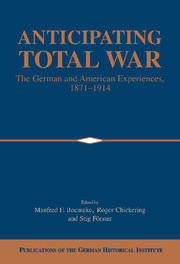Book contents
- Frontmatter
- Introduction
- Part One Germany, The United States, and Total War
- Part Two War and Society
- 3 The Political Economy of Warfare in America, 1865-1914
- 4 Hugo Stinnes and the Prospect of War Before 1914
- 5 War Preparations and Ethnic and Racial Relations in the United States
- 6 Religion and War in Imperial Germany
- 7 Socializing American Youth to Be Citizen-Soldiers
- 8 Preparing German Youth for War
- 9 Heroes and Would-Be Heroes: Veterans' and Reservists' Associations in Imperial Germany
- 10 Mobilizing Philanthropy in the Service of War: The Female Rituals of Care in the New Germany, 1871-1914
- Part Three Memory and Anticipation: War and Culture
- Part Four The Experience of War
- Index
3 - The Political Economy of Warfare in America, 1865-1914
Published online by Cambridge University Press: 05 January 2013
- Frontmatter
- Introduction
- Part One Germany, The United States, and Total War
- Part Two War and Society
- 3 The Political Economy of Warfare in America, 1865-1914
- 4 Hugo Stinnes and the Prospect of War Before 1914
- 5 War Preparations and Ethnic and Racial Relations in the United States
- 6 Religion and War in Imperial Germany
- 7 Socializing American Youth to Be Citizen-Soldiers
- 8 Preparing German Youth for War
- 9 Heroes and Would-Be Heroes: Veterans' and Reservists' Associations in Imperial Germany
- 10 Mobilizing Philanthropy in the Service of War: The Female Rituals of Care in the New Germany, 1871-1914
- Part Three Memory and Anticipation: War and Culture
- Part Four The Experience of War
- Index
Summary
introduction
This chapter deals with the political economy of warfare in America from approximately 1865 to 1914. By the political economy of warfare I mean the interrelationship of the political, economic, and military structures in devising the means to mobilize the nation's resources for defense and to conduct war. The magnitude and duration of the fighting dictates what the nation has to do to harness its economic power, but prewar trends largely determine how this mobilization takes place. Four factors determine the method of mobilization. The first is political: the size, strength, and scope of the federal government. The second is economic: the level of maturity of the economy. The third is military: the character and structure of the services as well as their relationship with civilian society and authority. Finally, it is necessary to assess the state of military technology.
Patterns of economic mobilization for war have passed through three major stages over the course of American history. The experiences in the War of Independence, the Civil War, and twentieth-century warfare best characterize these stages, which I have labeled preindustrial, transitional, and industrial. In the preindustrial stage, centralized control of economic mobilization was necessary because all institutions were weak. In the transitional phase, control from the center was less necessary for the Union because all institutions were relatively, but not exceptionally, strong. In the Confederacy, however, weak institutions everywhere demanded strength at the center.
- Type
- Chapter
- Information
- Anticipating Total WarThe German and American Experiences, 1871–1914, pp. 57 - 76Publisher: Cambridge University PressPrint publication year: 1999



